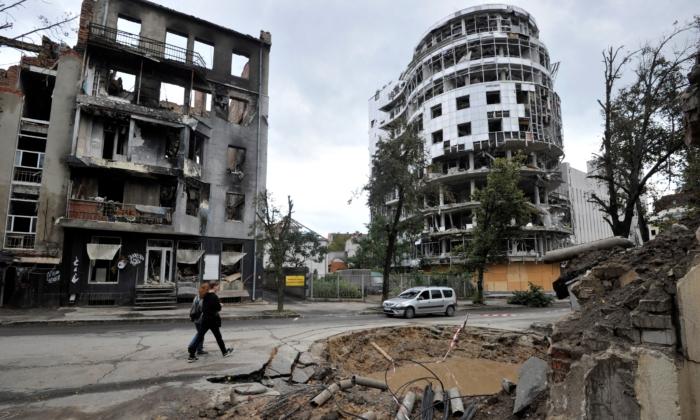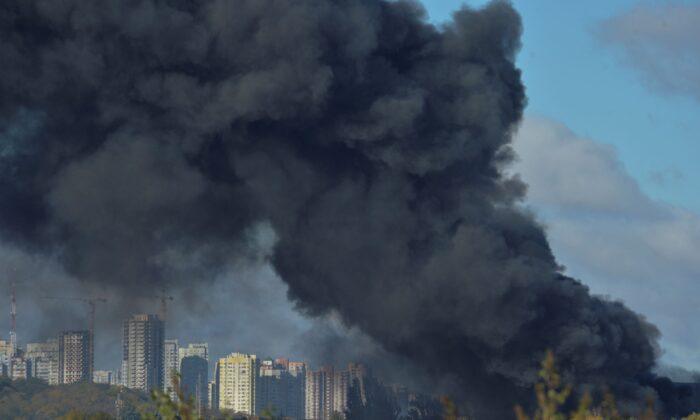The War So Far
Despite significant Russian gains in the east and south, which brought roughly 20 percent of Ukraine under Russian control, the Russian invasion largely failed.Ukrainian military forces stopped Russian attempts to encircle the Ukrainian capital of Kyiv and eventually forced their withdrawal from western Ukraine. More importantly, Russian forces failed to gain air control over Ukraine, shut down Ukraine’s communications, or destroy the Ukrainian military’s command and control capabilities.
Instead, armed with a growing supply of sophisticated American weaponry and almost a decade of Western military training, Ukrainian military forces successfully blunted the Russian advance, imposing unsustainable losses in men and materials on Russian forces.

Two weeks ago, Ukraine launched an unexpected counterattack that quickly recaptured several thousand square miles of previously Russian-occupied territory, including critical logistic hubs vital to the Kremlin’s war execution.
Attempts at a negotiated peace have been stillborn. The Zelenskyy government has made it clear that it will not accept anything less than the complete Russian withdrawal from Ukrainian territory overrun in 2022 and 2014.
Likewise, the Kremlin has shown little interest in a negotiated settlement requiring it to relinquish any captured territory, especially if that territory includes areas like Crimea that it considers existential to Russia’s future.
Kyiv will fight as long as the United States and its NATO allies provide aid and Russian troops occupy Ukrainian territory.
For its part, the Biden administration has been ambivalent about whether it will support such far-ranging objectives. Newly minted British Prime Minister Liz Truss has made it clear, however, that she believes that NATO should continue to support Ukrainian military forces until all Russian forces are expelled from Ukraine.
Russia and the EU
Russia’s relationship with the EU has been irreversibly broken. It will be a generation, at least, before European political leaders are willing to trust their energy supply to the Kremlin. Regardless of the outcome of the Ukrainian war, European leaders realize that relying on Russia for energy is political and economic suicide.
The EU has a difficult two to three years ahead to wean itself off Russian energy. So far, however, Europe’s political leaders seem committed.
Coal and oil have other sources, though these will be more expensive than in the past and will continue to inflate for the next several years.
Natural gas will be harder to obtain. In time, LNG exports from the United States, Australia, and the Gulf, and new pipelines to bring North African and Mediterranean gas, can replace Russian gas. LNG will require considerable infrastructure investment both at export and import points. All of this is doable, but it will take time and capital.
In the meantime, the EU will stress conservation and turn back to nuclear energy and coal-fired power generation to fill the energy gap. Those countries with unexploited gas resources, most notably shale gas in the United Kingdom, Germany, Poland, and Romania, will prioritize their development. The repeal of anti-fracking regulations in many EU countries, most notably Germany and France, is inevitable.
European political leaders plan to shield their citizens from skyrocketing energy costs by capping consumer costs and subsidizing power companies that would otherwise face insurmountable operating losses. It is the only way Europe’s political class will survive voter anger.
These subsidies will be expensive and will produce massive government deficits. The EU will offset some of those costs by imposing excess profit taxes on energy producers and nationalizing Russian energy assets in Europe. Berlin has already announced the nationalization of Rosneft’s German refineries. Gazprom’s significant European holdings will also be seized.
Russian gas was not just the primary source of Europe’s power generation and heating. It was also a primary raw material that was the foundation of core industrial sectors, from fertilizers to petrochemicals, and the thousands of secondary goods derived from those basic materials.
The high energy and raw material costs will cripple large segments of Europe’s industrial base. A cheap euro offsets part of that damage. Still, until Europe becomes largely self-sufficient in energy, a virtually impossible prospect this decade, large segments of Europe’s economy will be globally uncompetitive.
Can EU members issue trillions of euros of new debt while the European Central Bank is pursuing a tight monetary policy? Something will have to give. For the foreseeable future, the euro’s best days are behind it.
Europe’s central bankers will look back on dollar-euro parity with nostalgia as they face the reality of a sharply depreciated euro. Where the euro eventually bottoms is anyone’s guess, but a 75-cent euro isn’t outside the realm of possibility. A cheap euro will produce some significant financial winners and losers.
Russia is a big loser from the collapse of its economic relations with the EU. The EU was Russia’s largest energy customer. It was also a significant source of technology, consumer goods, and advanced machine tools.
In the short term, the Kremlin will reap increased income from rising oil and gas prices. In the long term, however, losing its EU markets and access to EU goods will cripple the Russian economy. Those losses cannot be offset by increased trade with China and India. Having written down their Russian assets and exited Russia, few Western companies will be interested in returning, regardless of the eventual outcome of the Ukrainian war.
The fault for the collapse of EU-Russian economic relations falls squarely on Russian President Vladimir Putin. The idea that Europe’s dependence on Russian energy was a decisive strategic lever was a belief long advanced by Putin.
NATO and the Degrading of Russian Military Power
Officially, the Ukrainian war is a conflict between Russia and Ukraine. In reality, it is a proxy war that pits the United States and its NATO allies against the Russian military. The net effect has significantly degraded Russian military forces, its personnel, and its equipment.It’s challenging to know the full extent of Russian military losses. Estimates of Russian deaths range from approximately 15,000 (the Pentagon) to over 50,000 (Ukrainian military). Estimates for casualties range between 50,000 and 100,000, depending on the source.

Russia has considerable military assets. Its army, including reserves, numbers some 2 million men. It has the largest tank force in the world and a significant nuclear arsenal. It also has a sophistical military-industrial complex and the ability to develop cutting-edge weaponry.
On the other hand, those military assets do the Kremlin little good if they can’t be operated effectively. The world’s biggest tank force is useless if it isn’t fueled. Likewise, the effectiveness of a 2-million-man army will quickly erode if you can’t feed it. The fact that Moscow has turned to North Korea for armaments implies far-ranging supply problems.
More significant is the demonstration that Russian military doctrine has evolved little since the end of the Cold War or even World War II. Elegant in theory but chaotic in practice, it still relies on applying overwhelming, indiscriminate force. The Russian army has demonstrated in Ukraine the ability to destroy everything in its path, regardless of whether it is advancing or retreating.
Power matters on the battlefield, but overwhelming power indiscriminately applied is a far less effective tactic in modern combat than in the past. Sophisticated weaponry, superior intelligence, and a targeted response have allowed the Ukrainian military to stop and roll back a much larger military force. Imagine if the Russian army was facing a fully trained and equipped NATO force backed by the considerable air power that NATO could unleash on a battlefield.
The United States and NATO are degrading Russian military forces without dealing with the consequences of an outright war between NATO and Russia. The billions of dollars in military and financial aid that NATO has supplied to Ukraine is a fraction of what it would have cost NATO—both politically and economically—to deploy its forces on the battlefield.
The Kremlin fully understands that it’s fighting a war with NATO—executed by Ukrainian proxies. It also realizes that, given its record in Ukraine, Russia’s military forces are in no position to fight a full-scale war with NATO. That is a conflict they are guaranteed to lose.
On the other hand, Putin also realizes that NATO is not in a position—militarily, politically, or psychologically—to fight a full-fledged war with Russia. The political consensus for committing NATO forces to a conflict with Russia doesn’t exist, and it’s unlikely that one can be cobbled together. However, the continued disclosure of Russian atrocities or the use of theater nuclear weapons might change that.
From the Kremlin’s point of view, one strategy to force NATO to reduce its support of Ukraine might be to precipitate an actual war between NATO and Russia—a plan of escalating to de-escalate. A Russian invasion of the Baltic states would force NATO’s hand to either mobilize its forces or seek a resolution in Ukraine.
Moscow’s Relations With Beijing
Russia has now become a vassal of China—little more than a supplier of commodities to feed China’s economy on terms and prices dictated by Beijing. One wonders what Russia’s Central Bank will do with the mountains of yuan it will accumulate.The erosion of Russian power and influence will have far-reaching consequences, especially in central Asia, a region where Moscow and Beijing have competed for influence.

Militarily, Russia and China are in a de facto military alliance. As the recent Vostok 2022 military exercise between Russia and China illustrated, the scope and depth of military cooperation between the two countries continue to expand.
From Washington’s perspective, it must weigh both countries’ joint military capabilities in assessing their threat to the United States. In the realm of nuclear weapons, the combined Russian-Chinese arsenal now dramatically exceeds the American one, and the gap is becoming larger. That makes future nuclear arms control agreements unlikely.
The transformation of the Sino-Russian relationship was underscored during the recent meeting of the Council of Heads of State of the Shanghai Cooperation Organization (SCO) in Uzbekistan. The 22nd meeting of the SCO was the first time Chinese leader Xi Jinping traveled outside China since the COVID-19 outbreak.
How the Legacy of the Ukrainian War Will Shape Beijing’s World View
In one sense, Beijing is the big winner of the Ukrainian war. Western economic sanctions are making Russia dependent on China as the primary market for its commodity exports and a source of technology and capital. Moreover, by elevating the threat posed by Russia to Europe, the Ukrainian war distracts the United States from the gravity of the threat posed by communist China to American interests worldwide.On the other hand, rising energy and food prices—both commodities China imports—negatively impact China’s economy.
Moreover, by visibly aligning itself with Russia, China has been tarred by the same brush of unprovoked aggression that stained Moscow. The parallels between Russian aggression against Ukraine and the prospect of similar Chinese aggression against Taiwan provide a template to respond similarly should Beijing attack Taiwan.
China’s relations with the United States and the EU have reached a tipping point. Beijing’s hyperaggressiveness in East Asia–especially its virulent, nationalist-driven reaction to House Speaker Nancy Pelosi’s visit to Taiwan—has pushed the United States to respond with new economic sanctions against China.
The White House recently announced that in response to Beijing’s aggressive behavior, it would henceforth ban the export of advanced semiconductor-making equipment to China and the export of airframes and technologically advanced aviation equipment and spare parts.
It’s unclear whether these actions signal a determination by the Biden administration to be more resolute in standing up to Chinese provocations and whether they will mean more American support for Taiwan.
It could mean that the retrenchment in U.S.-Chinese economic relations started by the Trump administration, which the Biden administration was expected to reverse, will instead expand.
That’s bad news for American companies heavily invested in China. The experience of Western companies disengaging from Russia is instructive. U.S. companies risk writing off their Chinese assets as China and the United States take increasingly different and antagonistic economic paths.
Chinese aggression against Taiwan would likely precipitate a broad and rising level of sanctions against China and a steady curtailment of trade and disinvestment.
Economically, China is more important than Russia to the United States and its allies. Disruption of China-centric supply chains would have far-reaching consequences worldwide. It would result in a sharp increase in inflationary pressures and significant shortages of goods and critical components.
On the other hand, such a disruption would hurt China as much, if not more, than the damage it would inflict on the rest of the developed world. Russia is largely self-sufficient in energy and food. China is not.
The economic sanctions imposed on Beijing could leave much of China’s population cold and starving in the dark. Whether the Chinese Communist Party would risk that prospect or survive such an outcome is anybody’s guess.
The war in Ukraine has fundamentally changed the world order that existed pre-COVID. While the eventual consequences of the Ukrainian war are not entirely clear, what is clear is that the world has changed irreversibly. No matter what happens in Ukraine, we will not be going back to business as usual!





